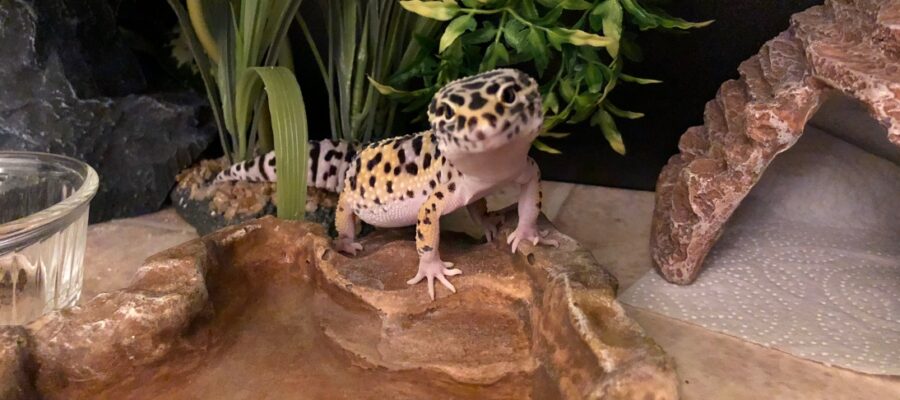The leopard gecko has become a popular pet, but it is important to learn about how they behave in their natural environment before buying one, because this will help you care for them in the best way possible, and also help you understand their needs and behaviours.
They are also very interesting and there are hundreds of fun facts about these small lizards
Habitat
The leopard gecko is a ground-dwelling lizard found in the highlands of Asia, Afghanistan, parts of northern India, Iran and Pakistan. Like all reptiles, lizards are cold blooded and ectothermic, meaning they cannot generate their own body heat. Instead, they rely on their environment to absorb warmth and energy as they are sleeping, so they can hunt and digest food at night.
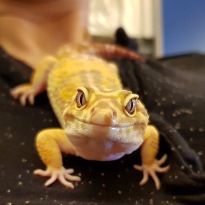 In their natural environments, warmer temperatures provide plenty of heat for leopard geckos through warm rocks and burrows. Leopard geckos are crepuscular, meaning they are most active at dawn and dusk when temperatures are favourable, as they do not like direct heat and sunlight. Winter temperatures in these areas can be quite low, below 10 °C (50 °F) which will force the geckos into semi-hibernation (brumation) where they live on the fat reserves stored in their tails.
In their natural environments, warmer temperatures provide plenty of heat for leopard geckos through warm rocks and burrows. Leopard geckos are crepuscular, meaning they are most active at dawn and dusk when temperatures are favourable, as they do not like direct heat and sunlight. Winter temperatures in these areas can be quite low, below 10 °C (50 °F) which will force the geckos into semi-hibernation (brumation) where they live on the fat reserves stored in their tails.
As ground-dwelling lizards, Leopard Geckos cannot climb up smooth surfaces. Instead of having adhesive lamellae, they have small hand-like claws which they use to grip. This is important to know for when you are thinking about housing your leopard gecko, because they will not need a particularly tall tank or vivarium – it is much more important for them to have a longer enclosure.
See: Housing and Setup
Appearence
Leopard geckos are larger than many other gecko species, and males can grow up to 10 inches in length, with the largest on record growing to 11 5/8 inches long (29.52 cm).
They have short legs compared to the size of their body, enabling them to quickly escape from predators. Leopard geckos also have great eyesight and hearing – perfect for helping them detect both prey and predators.
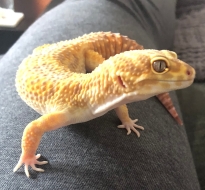 Their ears are found as openings on either side of their head covered and protected by a tympanic membrane – (if you try to look through their ears, you can see the light coming in from the other side of their head!)
Their ears are found as openings on either side of their head covered and protected by a tympanic membrane – (if you try to look through their ears, you can see the light coming in from the other side of their head!)
Their eyes are located on the sides of their head, giving them a great scope of vision. Their eyes are very sensitive to light, and they can see very well even in the darkest of conditions. One of the things about leopard geckos that makes them so unusual is the fact that they have eyelids which close (unlike many other reptiles).
Fun fact – leopard geckos are polyphyodonts and able to replace each of their 100 teeth every 3 to 4 months.
Healthy leopard geckos should have a plump belly and a thick, fleshy tail. The tail is where the gecko stores fat reserves, which makes them well-suited to times in the wild where food is scarce, or when they are forced into brumation due to cold temperatures. An unhealthy or malnourished leopard gecko will have a thin looking tail and body.
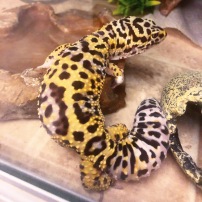 Leopard geckos also use their tail as a defence mechanism if they are attacked which serves several purposes. Firstly, it ensures the gecko can escape alive if it is grabbed on the tail by a predator. Secondly, a tail-less fleeing gecko has been reported to be able to get away quicker than one with its tail intact. Finally, the detatached tail can twitch and move for up to 30 minutes, acting as a decoy and allowing the gecko to have a greater chance of escape.
Leopard geckos also use their tail as a defence mechanism if they are attacked which serves several purposes. Firstly, it ensures the gecko can escape alive if it is grabbed on the tail by a predator. Secondly, a tail-less fleeing gecko has been reported to be able to get away quicker than one with its tail intact. Finally, the detatached tail can twitch and move for up to 30 minutes, acting as a decoy and allowing the gecko to have a greater chance of escape.
It is important to never grab a gecko by its tail when handling because of this. It is very stressful for the gecko to lose a tail, and costs the gecko a lot of energy to regrow it.
See: Why do leopard geckos lose their tails?
Those found in the wild typically have more dark, dull, and drab colourations which camouflages them from predators, however those kept in captivity as pets generally have an assortment of skin colors and patterns (known as morphs).
The skin of baby leopard geckos tends to be striped (it is thought that this is to mimic snakes, making them less attractive to predators) but this nearly always develops into spots, which also aid their camouflage as they mature.
Shedding
As the gecko is growing, they will need to shed their skin, and with each shed the pattern and colour will change until the gecko reaches maturity. This happens every 1 – 2 weeks for babies and juveniles, and less frequently as they mature.
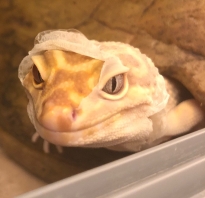 When keeping leopard geckos in captivity, it is important to give them the correct conditions in order to shed as they need moisture to loosen the skin. The gecko will then eat its old skin after shedding, as the shedding process uses up a lot of energy and the skin itself is a good source of protein and vitamins to replenish the gecko. Secondly, in the wild, if a gecko was to leave their skin lying around, this could draw predators towards them.
When keeping leopard geckos in captivity, it is important to give them the correct conditions in order to shed as they need moisture to loosen the skin. The gecko will then eat its old skin after shedding, as the shedding process uses up a lot of energy and the skin itself is a good source of protein and vitamins to replenish the gecko. Secondly, in the wild, if a gecko was to leave their skin lying around, this could draw predators towards them.
See: Why is my leopard gecko having shedding problems?


